Vintage linens can help you save money at the homestead table
(updated in 2015. Originally posted March 2012)
I recently read a post on going paperless. It was inspiring. It was radical. It might be too extreme for me. But it reminded me of the days when we were struggling as a young family to survive on a single modest income, and to live sustainably on our city homestead. We used to shun paper towels, paper napkins, even disposable diapers, throw away baby wipes, and feminine products — opting instead for cloth. But over the years, convenience has slowly pushed aside the frugal and environmentally conscious ethic that motivated our early family life — at least when it comes to disposable paper products.
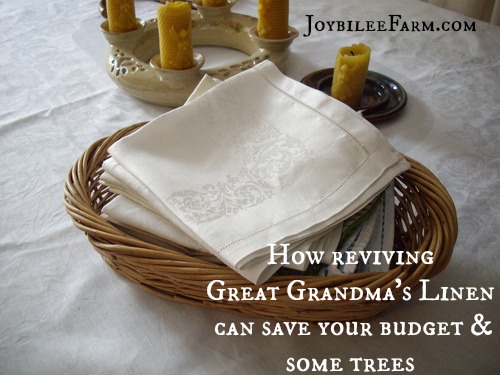
During my semi-annual trips to Costco I usually bring home $100 worth of paper towels, paper napkins, disposable feminine products, and of course, toilet paper. Each package comes wrapped in plastic. And the paper is bleached. While I’m not worried about the pulp trees used locally in paper making — the trees would be burned in slash piles after the area was logged for lumber trees, if it wasn’t for the paper mill in Castlegar — the paper making process is highly toxic and the finished paper is carcinogenic. Not exactly something you want to wipe your mouth with or dab across your babies cheek.
Dioxins are the culprit. Dioxins are a byproduct of treating wood pulp with chlorine. They are carcinogenic. If you add chemical dyes and inks to the paper so much the worse for your health. This should be motivation enough for me to make the switch to cloth products. But no, my own busy-ness and complacency is still winning the game. Tearing up old clothes for cleaning rags and dust cloths is a no brainer. Easy to do and fast. This I have done. But, to take out the portable sewing machine and upcycle some cotton shirts into napkins, or towels, or cheese cloths seems way more work than crocheting old jeans into rag rugs. Ok, I admit it. Not more work but mundane work.
But this article was just the push I needed to get off my keister and make a change. So I resurrected all the vintage linens in my house. However, after 30+ years of marriage some are looking a little tired. They are faded. Some of the hems are frayed. Some look too ugly to ever use, especially the ones made of polyester.
Why you don’t want to use polyester napkins:
You should never buy napkins made of polyester. Polyester is a manmade fiber, made from petrochemicals. You don’t want that near your face. Further, being a petrochemical, polyester attracts oils like a magnet, creating a permanent stain. Plus, they are impossible to wash clean. Polyester is another name for “microfiber” and like microfiber, they are electro-static. Put them through the dryer and they will attract every piece of lint, wool, hair or grime that you have hanging out in there. And then polyester napkins are not, at all, absorbent. I received 8 napkins made of 100% polyester as wedding gifts. I did use them and they are the reason that my long term use of cloth napkins ceased. On the other hand the best use for a polyester napkin is as a microfiber cloth in your “Swifter-type” dust mop. As I said, it will attract dust, lint, and grease like a magnet. You can wash it and reuse it. Polyester won’t wear out. Just don’t use polyester in a napkin.
What did great grandma use? Linens. They are vintage linens today. Linen napkins are the luxury napkins. They are lint free, soil resistant, antibacterial, and beautiful. They get softer with every washing and they last a lifetime. So yesterday, on our first trip to the big city in 6 months, I visited a thrift shop with a mission. While Robin looked through the men’s t-shirts for something that didn’t have a beer commercial on it, and Sarah looked for running shoes, I scooped out the vintage linens, looking for real linen napkins. I totally lucked out and I didn’t take them all. There’s some left for you.
How to identify vintage linens:
I found great grandma’s linen closet for real. There were vintage linen napkins and cotton napkins mixed up with gazillions of polyester and manmade fiber napkins. The thrift store had the napkins sorted by colour and had them fastened together in sets. This made it really easy to find what I was looking for.
Now vintage linen napkins won’t be marked as such. Lucky for you. If they were marked as “linen” you would pay a whole lot more. So keep this information to yourself, don’t let the thrift shop know you are on a quest, and they won’t know the treasures that they have lurking in the “Vintage Linens”. You will have to find the linen napkins by feel. Linen feels different than any other fiber.
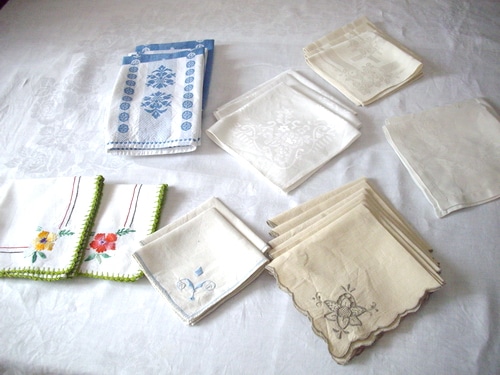
The feel of vintage linen
Linen has weight. When you hold a linen table cloth or napkin in your hand there is a spring and a weight to it. Polyesters crush easily in your hand when you squeeze them. Sizing in the fibers helps to overcome this, so if you have a polyester cloth that’s brand new it might imitate the spring of linen before washing. Linen maintains its spring and weight always. Even very fine linen that’s been washed many times retains that spring. Polyester napkins and table clothes will often have crisply ironed folds, but linen resists the fold line so when you fold a linen napkin it will just gently curve, without a crease. But if you want to create a fold crease in linen you will need a hot iron and steam or a mangle. It can be done but it takes work.
When you pick up linen it will be cool to your touch and you will feel the weight. Since linen readily absorbs water from the air it tends to feel cool. It seems heavier than polyester of the same fineness. If you practice caressing real linen, you will learn how it feels and then knowing the difference will become easier.
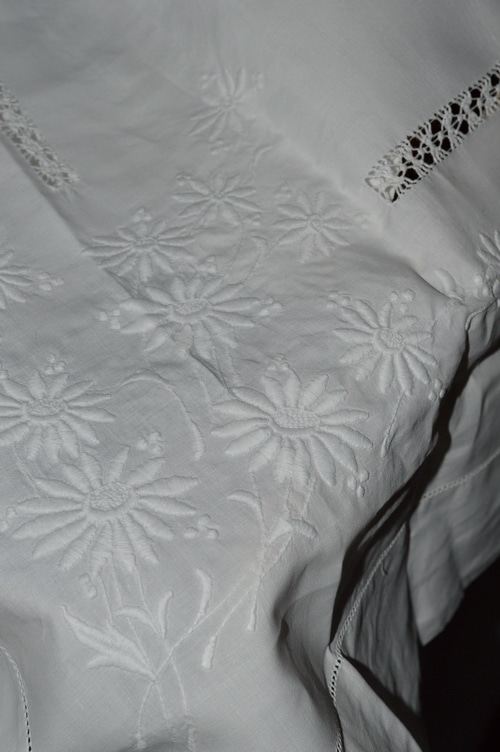
The look of vintage linen
Look for natural coloured or white fabrics. Linen is difficult to dye with chemical dyes. It resists staining so chemical dyes tend to fade quickly on linen. So most linen napkins are white or off white, most but not all.
Vintage linens have a glow and a sheen to them, naturally. The sheen is often maximized by the weave structure. Satin or damask weave structures really bring out the glow in linen. You will often find linen table cloths with patterned damask and the matching napkins, usually a minature pattern of the table cloth, glow and shimmer.
The threads in vintage linens are often thick and thin and you can see random slubs in plain weave linen cloths. Satin or damask cloths are more difficult to see the slubs in very fine weaves. Some polyesters mimic this attribute of linen but the slubs will be less random in a polyester cloth.
Bleached linen often has a greeny/bluey glow when held up to the light. This is especially true of vintage linens. The greeny glow is an attribute of older Irish linens and comes from the traditional bleaching greens, large tracts of grassy land that was set aside to layout linen yardage and bleach it in the sun. Polyester cannot mimic this.
The burn test of linen
While some polyesters mimic the feel of vintage linens, you might need to do a burn test to be absolutely sure. In a burn test, linen acts like a wick to the flame, and smells like burning grass or paper. It will remain glowing after its been blown out. It will leave a grey ash and won’t melt. Polyester will poof-up in the flame, smell caustic and acrid and leave a melted ball of gummy ooze. (Be safe: Do this in the kitchen sink and thoroughly soak the test fragment before you throw it away.)
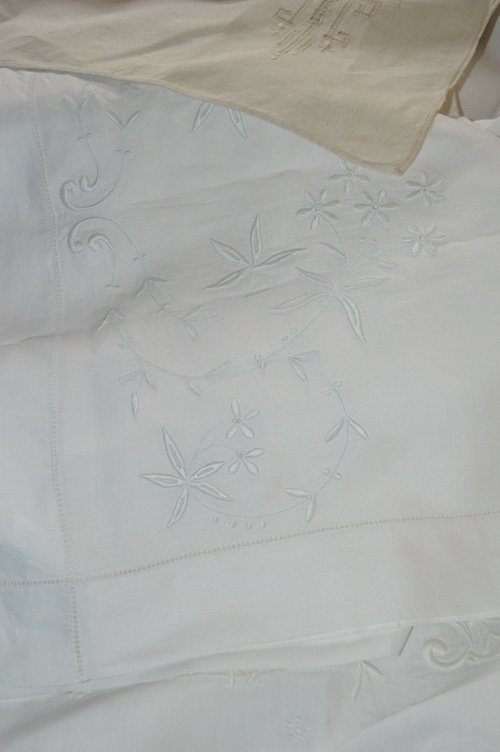
The durability of Linen
Because linen is such a fine fabric, you will find a lot of artistic flourishes in linen table cloths and napkins. Pulled hems are a classic linen touch. As are rolled and stitched hems. Cut work and embroidery are often done on linen, too. Linen that hasn’t been washed very often will be stiff almost like cardboard. After many washings it will soften up but initially the pectins in the fibers make it feel strongly starched. You may find in a group of vintage napkins, very white soft napkins along with more beige and stiffer feeling napkins. This is a dead giveaway to the presence of linen. Linen whitens and softens over time with many washings.
Linen is virtually lint free, so it won’t pill on the surface as cotton and polyester does with much wear. It will last for decades.
Cotton and linen
Cotton makes a very good napkin, too. It is another plant fiber and is very absorbent. If you are trying to tell the difference between cotton and linen, use the back of your hand. Linen is cool to the touch, because it readily absorbs moisture from the air. Cotton will be warmer. You can really notice this if you have both to touch at the same time. In the burn test its difficult to tell the difference between cotton and linen, but under a microscope cotton will look rougher and more wooly.
When you iron linen you use the very hottest setting and steam. You have to press hard to get the wrinkles out and create a smooth surface, due to linen’s longer fibers. Cotton, on the other hand, has shorter fibers and it is very easy to iron smoothly, so that is another clue.
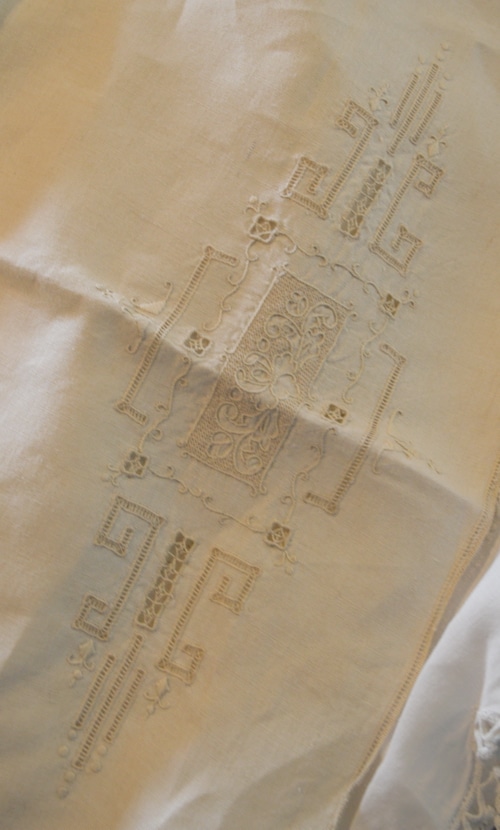
Doesn’t linen need to be ironed?
The choice is yours. Ironed linen has a deeper sheen and lovely smooth feel. But if you prefer to leave your vintage linens un-ironed, you can choose that option. It is only for you to know. Its your home. There are benefits to ironing linen though. Ironing is one more way to reduce bacteria in the cloth, along with washing and line drying in the sunshine. If you do choose to iron your linen, do it when the linen is still somewhat damp. Our great grandmothers sprinkled linen with lavender water and held it overnight to allow the linen to absorb it more evenly and then ironed it with a very hot iron. Lavender repels clothing moths. While linen is not usually attracted by moths, the linen can protect other clothing that is susceptible to moth infestation.
To make lavender water for your vintage linens:
3 cups of fresh lavender blossoms
3 cups of water
1/2 cup of vodka
Simmer lavender blossoms with water for 10 minutes. Allow to cool completely. Strain. Add vodka and bottle immediately. Store in a glass mister bottle. Mist linen before ironing or freshen linens in storage, periodically with a light mist.
Or try this Lavender Linen Spray.
How about the price?
I spent about $15 for a large package of paper napkins at Costco, 6 months ago. Yesterday I spent $17 and scored a 100% Irish Linen table cloth (hint: greeny glow) 84 x 60 size, 16 linen napkins and 4 exquisitely woven cotton napkins (possibly hand woven and dyed with indigo). If you have young children, who are at the messy, mashed carrot stage, you might want to set aside 8 to 10 linen napkins, just for company use and have another set of 20 napkins for every day. But rest assured, if you take the time to look for real vintage linens, your investment will give you many years of paper free table settings. If I couldn’t find linen my second choice would be a sturdy 100% cotton napkins. Lots of those at the thrift store, too.
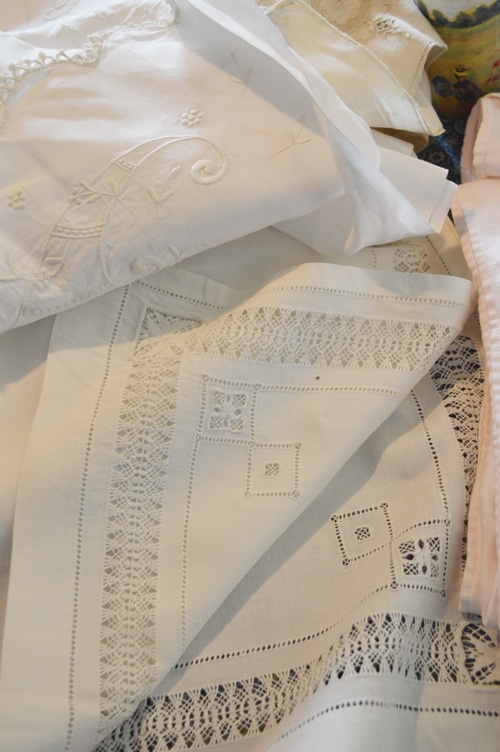
Heirloom vintage linens vs. modern linen fabrics
Finally, yesterday’s vintage linens are a valuable heirloom. In the past, linen was prized for its longer fibers, which gave it special qualities like longevity, smoothness, shimmer, and class. While it was stiff when new, over time and with many washings, linen became softer and even smoother. Today’s linen is different. The long linen fibers, which were once the prize of Ireland, Finland, France, and Belgium, are now processed in China. Because the processing of linen in the Old Way is labour intensive and expensive, because of its very long fibers, the new linen has been chopped to about the same length as wool fibers. This is called “cottonizing” and allows linen to be processed on wool and cotton milling equipment, saving both time and labour. However, the new linen is no longer as smooth as vintage linens. The new linen has lost its durability, as well.
Don’t expect new linen to last a lifetime. It has a similiar lifespan to cotton, now. It will still feel cold to the touch, but much of the smooth, glossiness has been replaced with nubbiness and some itch. What we call “linen” today, Great Grandmother would have called “flax tow” and relegated to the sacking and ropemaking crafts. To be true linen the fibers must be at least 12 inches long, and the new linen is much shorter, more like 4 to 5 inches, and some as short as 2 inches. So when you luck-out and snag some gorgeous vintage linens at the thrift store, don’t inform the store of your find. Keep the secret and grab the treasure, while you still can. Grab some for your daugher’s or grand daughter’s hopechest, too. Heirloom linen is on the endangered list.
Back to you:
What was your best thrift store find in the “household linen” aisle? What’s your favourite thrift store and in what town did you find it? Leave a comment.
More about Linen:
Linen from flax seed to woven cloth
Linen Heirlooms; The Story and Patterns of a Collection of 19th Century Handwoven Pieces With Directions for Their Reproduction.
Jane Napkin by Brini Maxwell (Set of 4, 18″ Square 100% Linen Napkins) – Buttercup



If you take wet linen, eg. a napkin and lay it on a smooth, flat surface, (top of dryer, piece of glass) to dry, it will be perfectly smooth, almost like you ironed it. This method was used when people had lots of cheap help and lots of smooth surfaces and before irons were popular.
I was just about to give away all of my Grandma’s old linens from around 1930-50 that I had been holding onto. Thank you for rekindling my value of natural fibers as the busy life had taken over and we have been using paper for a few years now. I can’t wait to get the linens back on my table.
If you haven’t ironed on top of the stitch pattern it will probably just wash out when you wash the piece, with no heroics. If that doesn’t work, test a small part of the design in an inconspicuous place with a diluted hydrogen peroxide soak. And the wash again. But cold water. If you have any heat — from the water, the dryer, or an iron, you can set the ink. (depending on what the ink is made of) But most cross stitch inks are designed to wash out.
Hello!
Wonderful article. I recently bought a large unused linen tablecloth at an estate sale that had been printed on with a blue crossstich pattern. (The owner never got around to crossstiching more than two napkins. ) I wondered if you knew what might I might try to use to remove the crossstitch ink from the fabric ?
That would be perfect – a short quote and image and a link back to your article. Thanks! I’ll send you the link to my article when it’s written. I’ve got a couple of trips out of town scheduled in the next couple of weeks so I expect to get it written by the end of the month. Thanks so much!
Penny